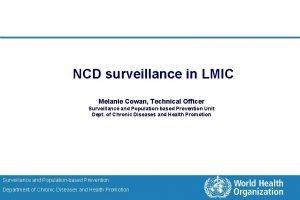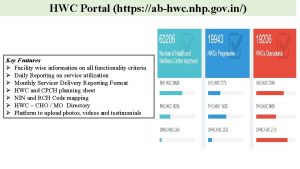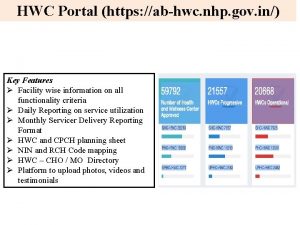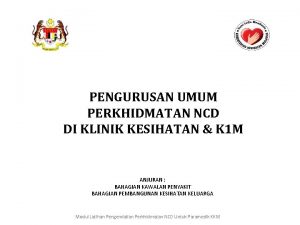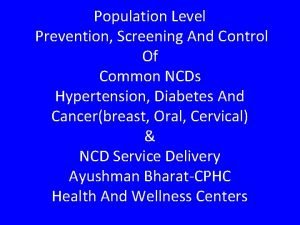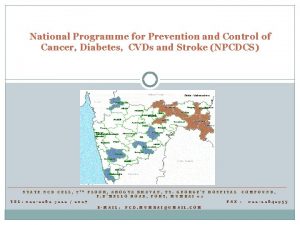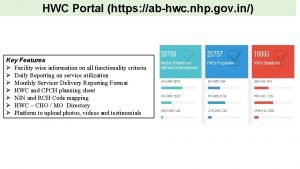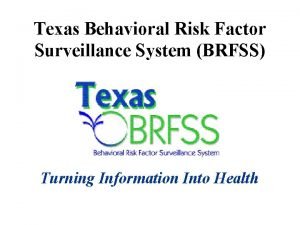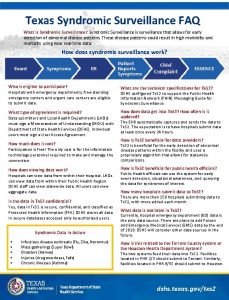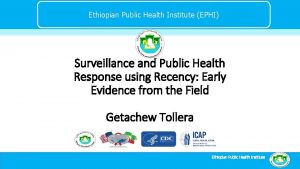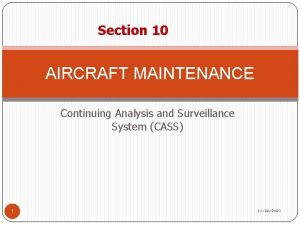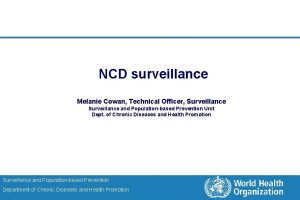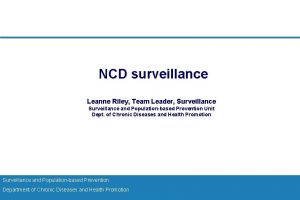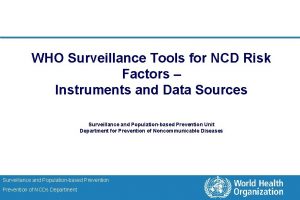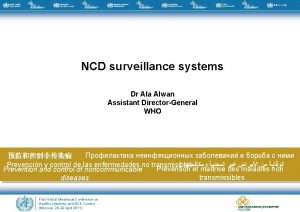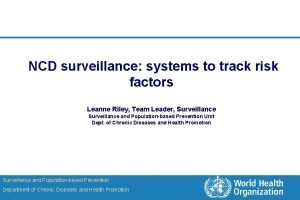NCD surveillance in LMIC Melanie Cowan Technical Officer






























- Slides: 30

NCD surveillance in LMIC Melanie Cowan, Technical Officer Surveillance and Population-based Prevention Unit Dept. of Chronic Diseases and Health Promotion Surveillance and Population-based Prevention Department of Chronic Diseases and Health Promotion

NCD Surveillance at WHO l STEPS l GSHS l NCD Country Capacity Survey (CCS) – Assessment of national level capacity to respond to NCD's in all WHO Member States – 3 rd round of data collection in 2010; previous surveys in 2000 & 2005 – Inclusion of results in 2010 progress report on the global status of prevention and control of NCDs Surveillance and Population-based Prevention Department of Chronic Diseases and Health Promotion

The STEPwise Approach to Chronic Disease Risk Factor Surveillance (STEPS) Surveillance and Population-based Prevention Department of Chronic Diseases and Health Promotion

What is STEPS? l "The WHO STEPwise approach to chronic disease risk factor surveillance provides an entry point for low and middle income countries to get started on chronic disease surveillance activities. It is also designed to help countries build and strengthen their capacity to conduct surveillance. " Surveillance and Population-based Prevention Department of Chronic Diseases and Health Promotion

Objectives l Empower Member States to gather information on chronic disease risk factors for use in planning health programmes and interventions. l Provide standardized questionnaire that allows for comparisons, but is flexible to meet Member States' needs. l Build capacity in Member States in all aspects of national survey implementation; in particular, develop skills in sample design, data collection and data analysis. Surveillance and Population-based Prevention Department of Chronic Diseases and Health Promotion

Current Activity # planning # in field / data entry or analysis work # reporting completed Total # active AFRO 10 18 15 43 (3) 7 AMRO 13 8 1 22 (3) 1 EMRO 2 7 9 18 (1) 7 EURO 1 1 0 2 (0) 0 SEARO WPRO 0 3 2 11 8 11 10 25 (0) (1) 9 7 120 Surveillance and Population-based Prevention Department of Chronic Diseases and Health Promotion # with # trained but 1 or more inactive repeats

Questionnaire Overview Different levels of risk factor assessment: l STEP 1 – questionnaire l STEP 2 – physical measurements l STEP 3 – blood samples Three modules per Step: l Core l Expanded l Optional Surveillance and Population-based Prevention Department of Chronic Diseases and Health Promotion

Questionnaire Overview, cont. l Behavioural Risk Factors – – Tobacco use Harmful alcohol consumption Unhealthy diet (low fruit and vegetable consumption) Physical inactivity l Biological Risk Factors – – Overweight and obesity Raised blood pressure Raised blood glucose Abnormal blood lipids l Optional Modules on Injury and Violence, Oral Health, Sexual Health Surveillance and Population-based Prevention Department of Chronic Diseases and Health Promotion

STEPS Methodology l Targets a nationally representative sample of adults aged 25 – 64. l STEP 1 (questionnaire) and STEP 2 (physical measures) are conducted in the household by trained interviewers. l STEP 3 (biochemical measures) is typically clinic-based. l Pocket PCs (PDAs*) are used for data collection: "e. STEPS" l Repeat survey should be done every 3 - 5 years. *(Personal Digital Assistant) Surveillance and Population-based Prevention Department of Chronic Diseases and Health Promotion

e. STEPS Features / Benefits l Improves quality of data collection with … – – automated Kish Method pre-defined skips automatic range checks immediate error checking l Fewer materials for data collectors to carry l No data entry needed l Multiple languages supported – English, French, Spanish, Arabic, Khmer, Georgian, Russian … l PDAs can be charged where power is unreliable by AA battery (cheap) or solar-power (expensive). l SD (external memory) cards provide data security in the event of PDA malfunction. Surveillance and Population-based Prevention Department of Chronic Diseases and Health Promotion

STEPS Methodology: The Surveillance Loop Recognize need for data on chronic disease risk factors Conduct STEPS Implement Interventions Data to Action Workshop STEPS Implementation Workshop Begin STEPS Planning Report Results Surveillance and Population-based Prevention Department of Chronic Diseases and Health Promotion STEPS Data Collection Workshop STEPS Data Analysis & Reporting Workshop

Training: Survey Implementation l Scope of survey l Identification of necessary resources l Questionnaire design l Sample design l Data collection logistics l Draft Survey Proposal Surveillance and Population-based Prevention Department of Chronic Diseases and Health Promotion

Training: Data Collection l PDA Basics l Locating and approaching households l Kish Method l Informed consent l Interview skills l Taking physical measurements l Taking biochemical measurements l Pilot Test Surveillance and Population-based Prevention Department of Chronic Diseases and Health Promotion

Training: Analysis & Reporting l Weighting data l Mapping data to generic STEPS Instrument (as needed) l Epi Info Analysis training – Half-day hands-on introduction – Running provided analysis code for descriptive analysis l Creation of STEPS Fact Sheet and Data Book (standardized reporting documents) l Begin draft of report and discuss dissemination plan Surveillance and Population-based Prevention Department of Chronic Diseases and Health Promotion

Training: Data to Action l Using STEPS survey results: – Propose development of new programmes / services or elaboration of existing ones to address key findings of survey l DPAS (Global Strategy on Diet and Physical Activity for Health) documents provide guidelines l Inter-Ministry collaboration Surveillance and Population-based Prevention Department of Chronic Diseases and Health Promotion

Support Materials l STEPS Manual – – – survey implementation plan template suggested timelines training guides for data collection and data entry staff data collection forms (e. g. participant information sheets, interview tracking forms) Generic STEPS Instrument l Sampling Tools – "STEPS Sampling Workbook" – "STEPS sample size calculator" Surveillance and Population-based Prevention Department of Chronic Diseases and Health Promotion

Support Materials: Sampling Workbook Surveillance and Population-based Prevention Department of Chronic Diseases and Health Promotion

Support Materials: Sample Size Calculator Surveillance and Population-based Prevention Department of Chronic Diseases and Health Promotion

Support Materials: e. STEPS Software Create (edit) Questionnaire on PC and transfer to PDA Data entry Import data from PDA to PC e. STEPS Questionnaire Designer e. STEPS Pocket PC (PDA) e. STEPS Manager Surveillance and Population-based Prevention Department of Chronic Diseases and Health Promotion

Support Materials: e. STEPS Guides l Installation Guide – Reviews PDA requirements – Provides step-by-step installation instructions for: • all prerequisite software • the 3 e. STEPS components l User Manual – Provides detailed instructions for: • how to use each e. STEPS component • how to manage the survey data and create the final dataset l WHO provides assistance with the creation of the questionnaire for the PDA and provides ongoing support via phone and e-mail during data collection. Surveillance and Population-based Prevention Department of Chronic Diseases and Health Promotion

Support Materials, cont. l Data Analysis & Reporting Tools – Epi Info and SPSS analysis programs (Stata coming soon) – standardized fact sheet and data book – survey report template Surveillance and Population-based Prevention Department of Chronic Diseases and Health Promotion

Support Materials: Analysis Help From generic STEPS Questionnaire From Fact Sheet From. Analysis Fact Sheet Analysis Guide Surveillance and Population-based Prevention Department of Chronic Diseases and Health Promotion

Support Materials: Analysis Help, Cont. From STEPS Generic Instrument From Data Book ex. Template page Surveillance and Population-based Prevention Department of Chronic Diseases and Health Promotion

Support Materials: STEPS website http: //www. who. int/chp/steps Surveillance and Population-based Prevention Department of Chronic Diseases and Health Promotion

Global School-based Student Health Survey (GSHS) Surveillance and Population-based Prevention Department of Chronic Diseases and Health Promotion

GSHS: Overview & Objectives l System for surveillance of behavioural risk factors and protective factors in school-aged children l Help countries develop priorities, establish programmes, and advocate for resources l Establish trends in the prevalence of health behaviors and protective factors by country l Allow countries and international agencies to make comparisons across countries Surveillance and Population-based Prevention Department of Chronic Diseases and Health Promotion

GSHS: Methods l Self-administered questionnaire and generic answer sheet l Targets grades with students aged 13 – 15 years l Completed by students during one classroom period l Anonymous and confidential l 10 Question Modules are available, from which countries can select a minimum of 6: – Alcohol, diet, drugs, hygiene, mental health, physical activity, protective factors, sexual behaviours, tobacco, violence & injury Surveillance and Population-based Prevention Department of Chronic Diseases and Health Promotion

GSHS: Training Survey Implementation Workshop Conduct GSHS • Sampling • Survey administration • Questionnaire Analysis & Reporting Workshop • Epi Info training • Analysis of data • Report writing Report Data Application and Program Planning Workshop • Policies • Programmes • Other interventions Repeat GSHS Implement School Health and Youth Health Programmes Surveillance and Population-based Prevention Department of Chronic Diseases and Health Promotion

GSHS: Current Implementation l Worldwide, 104 countries across all six WHO regions have been trained and 60 have finished GSHS data collection (including 9 countries with repeat surveys). Surveillance and Population-based Prevention Department of Chronic Diseases and Health Promotion

Questions? Surveillance and Population-based Prevention Department of Chronic Diseases and Health Promotion
 Melanie cowan
Melanie cowan Aefi surveillance officer
Aefi surveillance officer Halo 3 cinematics
Halo 3 cinematics State bayes theorem
State bayes theorem Interaktionale ebene
Interaktionale ebene Jake cowan newcastle
Jake cowan newcastle Cowan statistical data analysis pdf
Cowan statistical data analysis pdf Ncd nhp gov
Ncd nhp gov Https//ab-hwc.nhp.gov.in/daily report
Https//ab-hwc.nhp.gov.in/daily report Klinik paramedik
Klinik paramedik Ncd anm login
Ncd anm login Ncd center dh amravati address
Ncd center dh amravati address Ncd jhs telangana gov in
Ncd jhs telangana gov in Menno van hilten
Menno van hilten Schoology ncd
Schoology ncd Ab-hwc.nhp.gov.in login
Ab-hwc.nhp.gov.in login Texas brfss
Texas brfss Class diagram for safe home security system
Class diagram for safe home security system Texas syndromic surveillance
Texas syndromic surveillance Séminaire débitmétrie
Séminaire débitmétrie Airborne surveillance applications
Airborne surveillance applications Surveillance definition
Surveillance definition Ephi ethiopia
Ephi ethiopia Ul market surveillance
Ul market surveillance Continuing analysis and surveillance system
Continuing analysis and surveillance system Syndromic surveillance
Syndromic surveillance Surveillance of
Surveillance of Syndrome malin surveillance ide
Syndrome malin surveillance ide Drain d escat
Drain d escat Chirurgie thoracique infirmier
Chirurgie thoracique infirmier Surveillance detection route
Surveillance detection route
